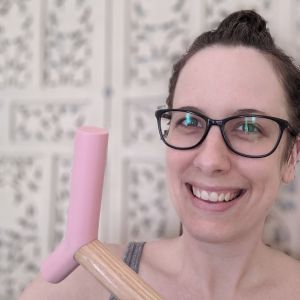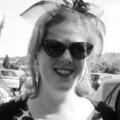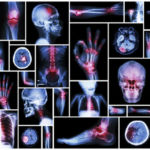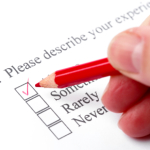For our November newsletter, journalist Karina Sturm interviewed Brianne Benness, the host of No End In Sight, a podcast about life with chronic illness and a chronically ill person’s journey to diagnosis. She is a co-founder of Stories We Don’t Tell, where she talks about hypermobility, mast cell disorders, and recontextualizing old experiences using new frameworks. Benness has also created an online community on Twitter, #NEISvoid, where people can meet and discuss chronic illness and symptoms, whether they were diagnosed with a chronic illness, or not. In this interview, Benness shares her journey to getting diagnosed with EDS, POTS, and other comorbid conditions, the challenges she faces throughout daily life and how she copes with those, what motivated her to start the hashtag #NEISVoid, and what others should understand about chronic illness.
Karina Sturm:
Hi Brianne! I am so excited to finally meet you in person. I have been following you on Twitter for quite some time and love what you are doing! Would you mind sharing a bit about yourself? Where do you live, what do you do and what chronic illnesses do you live with?
Brianne Benness:
I live in a small town in rural western Massachusetts, and I mostly do online-related work, but I cannot work full-time due to my health. I’ve been diagnosed with Hypermobile EDS, POTS, small fiber neuropathy, and mast cell activation syndrome. Many people with one of those conditions will eventually be diagnosed with all of them. And I also have vasovagal syncope, which is triggered fainting, separate from the POTS.
I used to live in Toronto for a few years, where I had a much busier life. I slowly moved out of that, as my health was falling apart, and I didn’t know what was happening. Today – since I know what’s causing my symptoms – I’m more committed to living slowly, trying to accommodate myself, and resting whenever needed.
Sturm:
When did this all start for you? When did you develop your first symptoms, and how did they progress?
Benness:
I’ve had symptoms episodically for my whole life, but we didn’t really recognize them as part of a larger pattern. I know now that I definitely showed signs of POTS back to when I was at least ten or eleven years old; I experienced injuries that nobody recognized. It did not make sense without the framework.
The fainting was diagnosed first when I was 19 years old because it is so obvious when you faint in public. Additionally, I had mononucleosis when I was a teenager, and I was really sick with that for a long time. I was out of school for over a month, and I never really recovered. But I didn’t, at that time, have any models for understanding or interpreting it. I remember, as a teenager, I asked myself, “Do I have chronic fatigue syndrome? And what does that mean?”
Then, through my twenties, I didn’t think anything was wrong, but I had periods where everything was just really hard, and I didn’t know why. I was able to burn myself out for another decade until I was 28 or 29, and I moved into an apartment that had mold in it. I developed bad eczema, which spread all over my torso. I went to my doctor and tried all kinds of treatments, but nothing helped.
I ended up doing an elimination diet, which made the rash go away. This was when I realized something different was going on here. Today, I recognize that that was related to mast cell activation syndrome. From then on, things were getting harder and harder. I had to stop working. I saw many specialists, and when I was 31, POTS and small fiber neuropathy were diagnosed.
Then in January 2020, my husband and I both got really sick with a viral infection. We don’t know for sure what it was, but we have strong suspicions that it was COVID. I started to have the typical spiral of an unmanaged cascade of symptoms. I dislocated my shoulder, and my injuries were going up. I ended up having a CSF leak. I was in bed for five months with that. I didn’t know how to explain this to a doctor, so I was talking more to other people in this cluster, and that was when I finally figured out the right questions to ask. I found a physical therapist who specializes in hypermobility, and she ran me through the Beighton Scale and did an assessment. She said, “Well, you’re not classical EDS, but your range of motion is certainly hypermobile. Your shoulder behaves like a shoulder that has recently been dislocated.”
Sturm:
So for you, one thing led to another, and your final diagnosis was EDS?
Benness:
Yeah, the process was probably four or five years from when I was so impacted that I couldn’t work anymore to when I had a good enough understanding of where I could start to find answers.
Sturm:
How did you get from being unable to work to where you are today? What kind of adjustments did you make?
Benness:
I think there are two things that I would describe: one is environmental, and one is tactical. In my twenties, I worked in communications and marketing. I had already spent a lot of time thinking about available tools for streamlining and automation. Then, during 2020, I was in bed full time. I wanted to stay connected to people, but I was really foggy. I couldn’t read or write, and I had to quit doing my podcast.
I wanted to find a way to work without hurting myself, which I had never done before. I think a lot of people within the community share that experience. School was always about ignoring my injuries. Work was always about ignoring my injuries. And that’s a path of burnout, as a lot of us learn the hard way.
I started working on the #NEISVoid hashtag at that time because it was something that I could do without deteriorating my condition more. I felt like I was a part of something, and the work itself was accessible to me. I really let go of how I should work and how I had worked before.
Additionally, I adapted my work environment. I’ve tried a lot of adaptive tools. For example, I started to use braces such as a shoulder brace and splints. I also got a tablet with an arm and a keyboard and mouse to connect to it, so it’s much easier for me to work lying down. I set up a fully horizontal workstation. I can’t write on days when my brain is really foggy, but on other days when I have an injury, and I’m comfortable lying down, I can do all my writing in that position.
Some weeks I work a lot, and some, I don’t really work at all. I also try to let myself off the hook for that. I’ve tried to really get rid of deadlines in my schedule, as well, because they caused too much stress. I am still learning. It’s a slow and steady process.
Sturm:
What are your biggest challenges throughout everyday life these days?
Benness:
I think going out into the world has gotten so much harder now that everything is different. I know a lot of people are in this position as well. As I have gotten some of my strength back, the current situation is really getting to me. I could go out and meet people, but it’s not safe. So, the entire mess of the pandemic is a big challenge.
And then privately, even though I am now able to work horizontally, I’m still learning how to do other tasks at home. My husband does pretty much all the food prep in our house, and I miss cooking. We haven’t figured out how to cook lying down. [Laughs.] I’m so grateful that I live with someone who can support me in those ways and make sure that we both stay fed and functional.
I don’t know the models for building an accessible space when my access needs are really different from other people’s. As a side note: my master’s degree was in architecture. So, in my day-to-day life, I feel like I’m still building up the skills and environment to get more independent. It’s not simply one thing. It’s the way all the things layer together.
Sturm:
How do you cope with those challenges?
Benness:
I love building the world for lying down. Now that I’ve accepted that it is a good way to be. That’s a huge part of my coping strategy right now. I’m also trying to focus on physical comfort in terms of temperature management. I’m at a very basic level of “let’s get the body comfortable.” Additionally, having a community is a huge part of coping with isolation and not knowing.
I don’t have the energy for conversing back and forth, but something like Twitter, where people are sharing small bits of their experiences, gives me a lot of comfort. Just seeing us all doing that in our little homes, making progress, supporting each other, and sharing our tips for comfort makes me feel so much less alone and more connected to people at a time when both illness, and the extra layer of COVID, are so isolating.
Sturm:
What motivated you to speak out about all of this publicly?
Benness:
I had already spoken about illness in my “before-life” when I lived in Toronto. I founded a storytelling event there, “Stories We Don’t Tell,” with two other people. I developed a monthly event where I would write a lot about my own experiences as part of the lineup.
This gave me a better sense of how we all are talking about our bodies and what it is like to be moving through the world where you’re having this internal experience, but the outside world is oblivious to it or asking you to pretend it’s not happening.
So, when I was getting sicker and sicker and becoming more isolated because I stopped working, I started to ask the same questions as I had already been doing at the events with the goal of feeling less alone.
In 2017, I really started to talk about chronic illness on Twitter. I was like, ‘Okay, this is what it is like to be in my body; this is my perspective. I didn’t want other people to validate it so much as I was looking for other people to connect with, which is different. I didn’t care to talk to people who didn’t know what I was talking about. I wanted to find other people who relate to my experience because being alone sucks. So, it started from there.
At that point, I didn’t know what was happening to my body. I still wasn’t sure that anything was wrong. I thought maybe I was depressed; maybe I was imagining it. So, I needed to understand, and I wanted to talk about it with other people.
Sturm:
And this is when you created #NEISVoid?
Benness:
Pretty much. I started following lots of chronically ill people, and I asked questions like, “Has anybody ever felt this way? Has anybody ever had this experience?” We’re all having the same experiences, but the outside representation isn’t reflecting that.
In 2019, my Twitter experience started to change. More people started to follow me, and I still wasn’t diagnosed. The hashtag was created in March 2020, while people’s energy changed too. They were worried and asked, “Are we going on lockdown? Are we going to be really isolated? How worried should we be? Why wasn’t anyone else worried?”
I’d been thinking about how to help those people and centralize them. #NEISVoid was an experiment. I created the void where one can shout into, and maybe some supportive people will yell back. And because I had done the storytelling event previously, I had already thought a lot about: What are we worried about when we share vulnerable things? What am I worried about when I talk about undiagnosed illness? What am I worried about when I talk about grief?
Well, I’m worried that someone will not believe me. I’m worried that someone will laugh at me. I’m worried that someone will argue with me about my own experience. I didn’t want to set people up for harassment. So I created a hashtag that is not recognizable as meaning anything. Additionally, I made three simple rules for engagement so that everyone knows what to expect when they use it, and that will be the operating system.
I don’t have a lot of energy to moderate. I couldn’t moderate a Facebook group or a subreddit. I was very much in the space of: What can I do without losing all my energy? I can just ask people to use the hashtag, and if they use it, we will retweet it. And that is the whole system.
Sturm:
What do you want non-disabled people to understand about the hashtag?
Benness:
One of the biggest things that I want people to understand is that most disease-focused organizations are looking at the diagnosis and the time afterward. But the reality is that receiving a diagnosis can take so long for complex and chronic illnesses. Like with EDS, the average for women is 16 years, and for men, it is four years. Frankly, both are egregious, although one is more egregious than the other. That’s an incredibly isolating time for people because they’re already sick.
People need to understand that the diagnosis is not when an illness starts; it starts with symptom onset. And people need support from symptom onset. People are reaching out on Twitter, because they don’t have anywhere else to go, and we’re mostly just validating. If your body is acting weird, then you belong here. You don’t have to go through that alone.
Sturm:
What’s the number one takeaway you want your followers to have?
Benness:
One thing I want my followers to take away is that we can build the world for ourselves. We can build communities for ourselves. You can just start small with easy things, and you can experiment, and you can invite people who get it to join you.
That’s how we build community.
Sturm:
That’s so true. Thank you so much for sharing all of your insight with me!
Benness:
My pleasure; it was lovely to chat.
Sturm:
Thank you.
All images: Adam Zawalich
By Susan E. Jackson and Karina Sturm
November 2022



